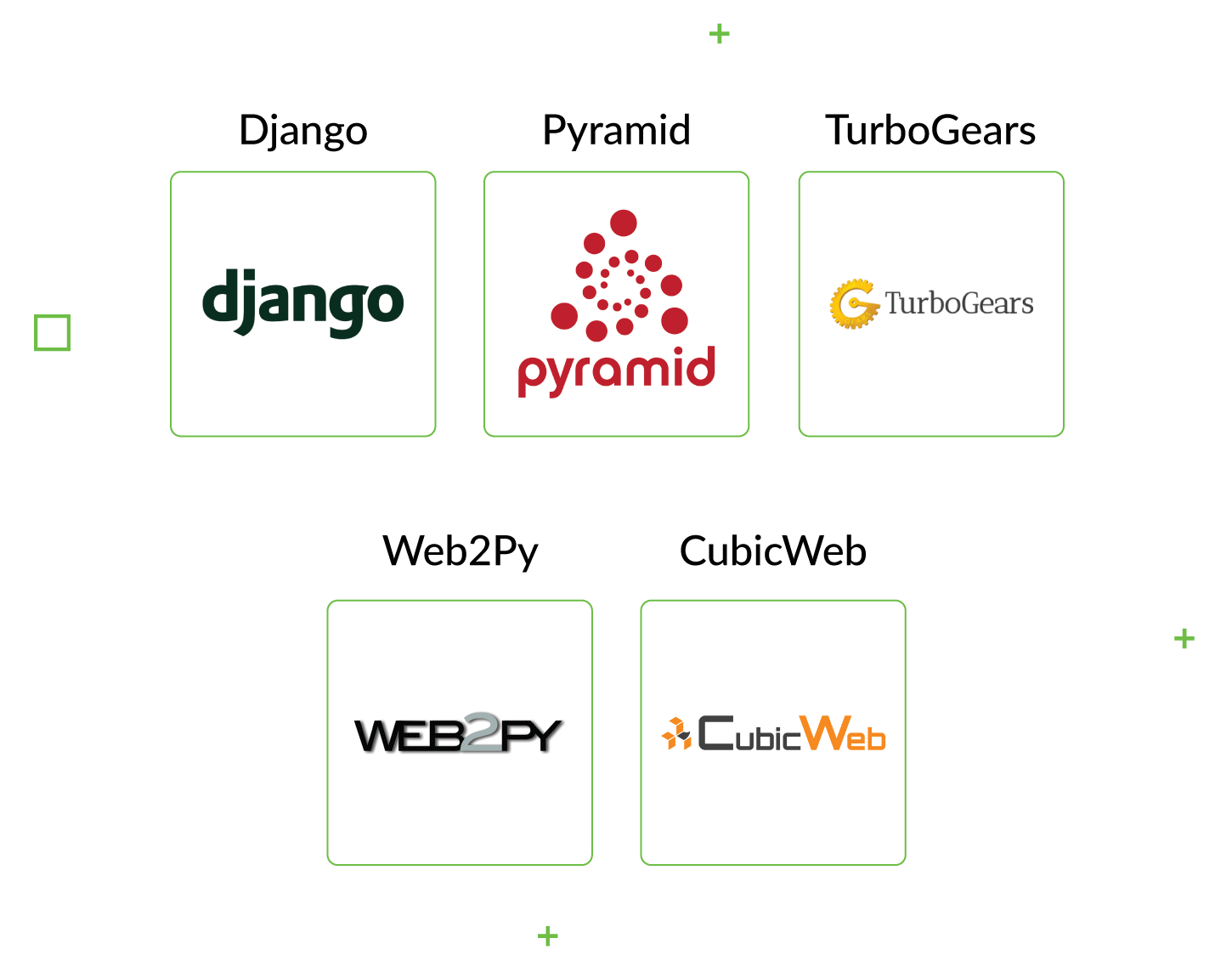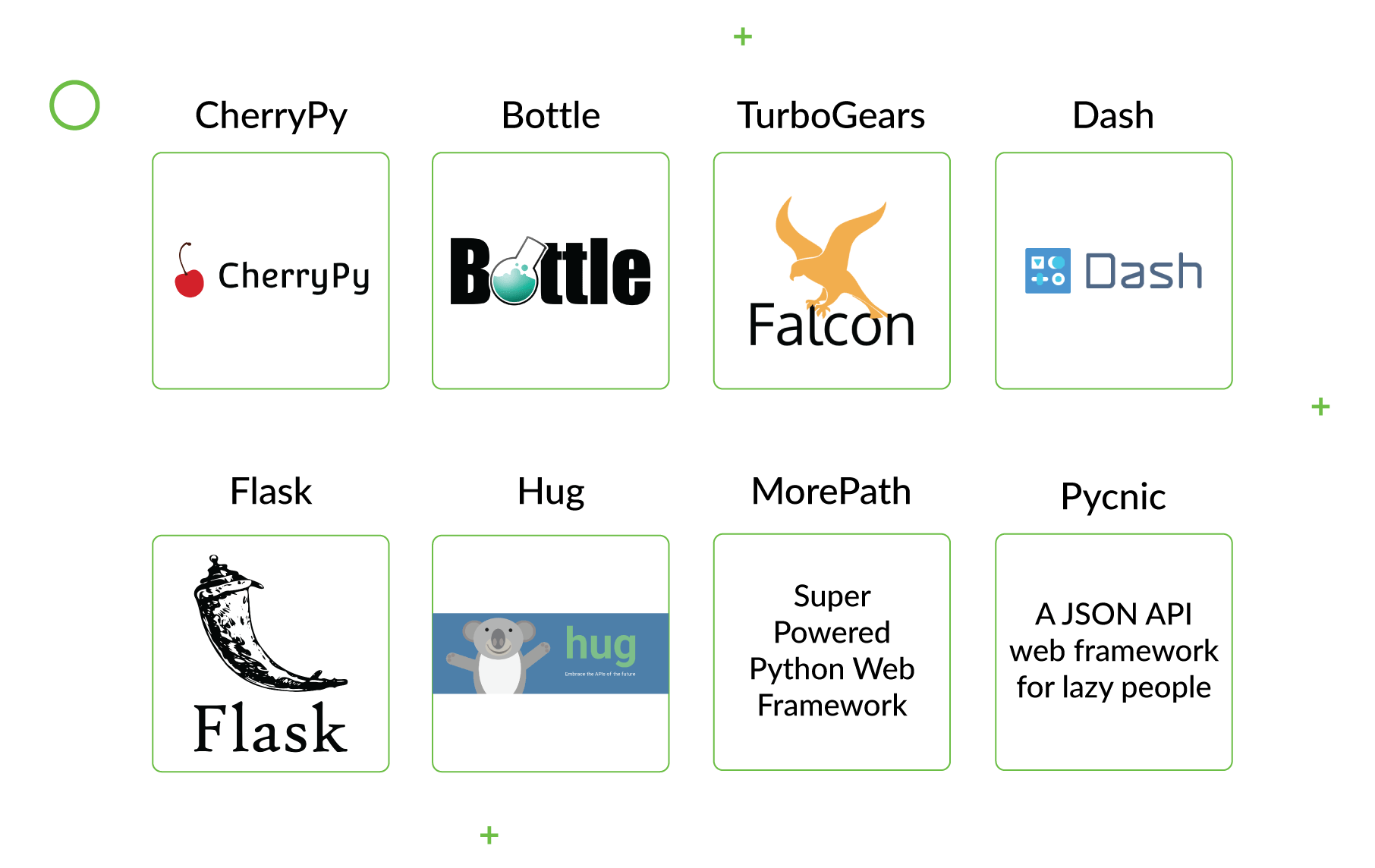Top 16 Python Frameworks for Web Development

Python is the choice of many programmers and tech companies due to its simple syntax, extensive libraries, capacities for development and testing automation. From financial & banking systems to travel platforms, it’s a solid fit for many projects, including teams looking to build a crm with Python. It can take your project from zero to a hundred in terms of complexity, whether it’s a simple website with limited functionality, an API, or a complex solution incorporating machine-learning algorithms. And there are numerous Python frameworks for web development to facilitate this task.
The Django Stars team has been using Python for over 15 years in combination with various frameworks, primarily Django, developing software projects in fintech, travel and booking, e-commerce, and other industries. Our developers know the ins and outs of this field and are ready to discuss all you want to ask about Python and its frameworks.
Which one is the best Python web framework? As will be seen from the overview below, there’s no answer for all occasions. The choice depends on your goals.
All Python frameworks can be grouped into three broad categories: full-stack, micro, and asynchronous.
- Full-Stack frameworks come pre-packaged with everything you need to build an app. Things like the MVC (model-view-controller) architecture, Django ORM (object-relational mapping) technique, a templating engine, and routers. Full-stack frameworks can be used to develop any kind of application, but it’s more common to use them for bigger projects.
- Microframeworks come with the bare essentials for developing apps that involve minimal coding. They might lack functionality such as form validation or a database abstraction layer, but they can be extended with the databases or templating engines you require. Some microframeworks can easily scale to a full-stack solution.
- The concept of asynchronous coding isn’t new, yet not many asynchronous frameworks support it. Following this concept, an app doesn’t need to execute tasks consequently: one task can start running before the previous one is complete. Python asynchronous frameworks use the asyncio library and can handle huge sets of concurrent connections.
We will go through the best python libraries for web development and give our recommendations on which of the most popular Python frameworks are good to use, their advantages and disadvantages, features, examples of when they’re used, as well as handy comparison tables.
Best Full-Stack Frameworks
Let’s first tackle the full-stack web development frameworks in Python which, although they might be excessive for a small app, are suitable for a wider variety of projects.
Django
Official website | PyPi | GitHub | Stack Overflow
Django is a high-level python web development framework with a focus on making the development process more efficient and quick. More precisely, Django’s design philosophy saves you time and money, and a number of its principles – like DRY and rapid development – encourage developers to minimize code and reduce redundancies.
Area of application: Web development
Framework features:
- Database version control
- A templating engine
- Object-relational mapper (ORM)
- URL routing
- Support for web servers
- A wide variety of ready-to-use libraries
- Support for authentication
- Support for internationalization.
- A wide variety of ready-to-use Python libraries for web development.
The Pros of Using Django
Batteries included motto — saves you time
You don’t need to code basic functionality, since it comes pre-packaged and can be easily imported when you start a project. These packages were developed by professional developers, so you won’t need to spend time making sure they work correctly. Some of the packages include authentication, Google sitemap authentication, and session management.
Strong community and good documentation
From beginner to pro, Django unites a solid, helpful community that actively works on stabilizing and improving the framework, as well as helps each other out. Along with that, Django offers thorough documentation, so it’s easier to understand the various features.
Scalability
An essential feature of many projects is scalability. Especially if you’re a startup that doesn’t know how much it can or will grow, Django provides the functionality that enables you to create a small project and scale it as needed. You can handle more user requests and greater volumes of data if your web app goes through a growth spurt.
Admin panel
Django has an admin interface, so you can manage data using basic CRUD operations. It’s an “out of the box” solution, so you can start your project right away, without having to code this functionality.
Cons of the Django framework:
- Django isn’t the go-to framework for creating real-time apps, since it doesn’t support WebSockets.
- Since it comes pre-packaged with ready-to-use features and libraries, it might seem monolithic, as if there’s only one way of doing things.
Project examples:
- Instagram — a popular social media app for sharing photo and video content.
- Spotify — a music distribution platform that helps users discover new artists based on the user’s preferences.
Pyramid
Official website | PyPi | GitHub | Stack Overflow
If you’re a fan of minimalism, the Pyramid framework is a good alternative. The framework suits any size of project and offers many features for creating complex applications or when you are scaling a small application.
Area of application: Web development
Features:
- Specification of asset location in a package
- Use of predicates and renderers
- URL generation.
The Pros of Using Pyramid
It’s flexible and easy to customize
Any component in this framework, like a templating engine or database, can be swapped out for another one. You can also use multiple components for the same app (such as two URL mapping methods) or connect to two completely different (by type) databases.
Easy use of Ajax requests
It’s simple to send Ajax requests where you want them, thanks to XHR views and decorators. It’s a rather straightforward process in terms of development.
Support of SQLAlchemy
If your project is SQL based, SQLAlchemy is a powerful database that allows you to create complicated queries and stay sane.
Cons of Pyramid:
- You need to spend some time preparing the tools;
- You need more experience with Pyramid to customize it properly;
- For simple apps, SQLAlchemy might be rather unhelpful.
Project examples:
- Charte.ca — an online chart editor, suitable for non-technical users.
- Easy Blog Networks — a Django hosting and maintenance provider.
- Substance-D — an environment for developing web applications.
Turbogears
Official website | PyPi | GitHub | Stack Overflow
TurboGears is an open-source framework used for rapid development of data-driven web apps. It’s a great option if you want to develop an app that requires database connectivity, since TurboGears supports tools such as SQLAlchemy, Genshi, WebOb, and Repoze.
Area of application: Web development
Features:
- Horizontal data partitioning
- Integration with MochiKit JavaScript library
- Function decorators
- Support of multiple databases
- Support of MVC architecture
- ToscaWidgets
- PasteScript templates
- Validation support with FormEncode.
The Pros of Using Turbogears
Versatility
Though it’s a microframework, Turbogears is easy to scale up to a full-stack solution. You can easily put together a prototype and then scale it to a complex, fully fledged application.
Built-in extensibility with Pluggable Applications
You can create your own plug-in modules to replace or extend existing modules in the framework. All of them will remain fully under your control.
Cons of the TurboGears framework:
- You might feel overwhelmed by the freedom to extend the framework in whatever way you want.
Project examples:
- Apache Allura — an online platform for managing code repositories, originally developed at SourceForge.
- Kamisons – an eCommerce platform for selling umbrellas.
Web2Py
Official website | PyPi | GitHub | Stack Overflow
Web2Py is a scalable framework with a web-based Python IDE (integrated development environment). Web2Py has a ticketing system for issuing tickets to users whenever an error occurs.
Area of application: Web development
Features:
- Backward compatibility
- Role-based access control
- Built-in data security
- Support for the MVC architecture
- Multiple protocol readability
- Support for internationalization.
Pros of Using Web2Py
Flexible, powerful, and extendable
Web2py is a good option for complex applications, as well as for simple, beginner-friendly apps. It has enough features for efficient development, but can also be integrated with external libraries.
Maintainable over time
It is easy to pick up source code from another team and continue to maintain the app. Plus, if the code is rather old, it will still run on the latest versions of the framework.
Community support
Web2Py has a good community where you can find help with mastering the framework or solving more complex tasks. You can even get answers directly from the framework’s author, Massimo Di Pierro.
Disadvantages of Web2Py:
- An inflexible plugin system
- Difficulties in managing the data models loading system
- Unorthodox design patterns
- No support for Python 3.
Project examples:
- IMSA — Illinois Mathematics and Science Academy.
- iTel Networks — cloud services for businesses.
- Showcase Workshop — a mobile content marketing platform.
CubicWeb
Official website | PyPi | GitHub | Stack Overflow
CubicWeb is a semantic web framework driven by the application data model. Instead of models or views, this framework uses cubes that can be joined together via a web server, database, and configuration files.
Area of application: Web development
Features:
- Multiple database support
- Resource Description Framework (RDF) support
- Mercurial and Subversion backend storage
- Reusable components
- Web Ontology Language (OWL)
- Semi-automatic generation of text, JSON, XML or XHTML via a selection+view mechanism.
Pros of Using CubicWeb
Reusable cubes
Like Django and some other top Python frameworks, CubicWeb encourages developers to reuse components (which, in this case, are called cubes). Using cubes multiple times instead of writing code from scratch each time is a significant time-saver.
RQL queries
RQL, or relation query language, is designed to have a clear syntax for querying relations, giving you an easy way to manipulate data repositories and browse through relations or attributes.
Cons of CubicWeb:
- An excessive number of functions that could potentially make it harder to work on certain projects.
Project examples:
- Logilab — a software company that specializes in the semantic web and scientific computing.
Comparison table of Full-Stack Frameworks
Best Microframeworks
If you have a small or mid-range project, here are our top microframework picks. So let’s check this Python frameworks list.
CherryPy
Official website | PyPi | GitHub | Stack Overflow
CherryPy is a minimalistic framework and a good choice for developing data access or templating technologies. It is fast, simple to use, and offers multiple out-of-the-box solutions to handle almost any type of project, from the least to the most demanding ones.
Area of application: Web development
Features:
- A built-in plugin system
- Built-in coverage, testing, and profiling support
- An HTTP/1.1-compliant WSGI thread-pooled web server
- Support for multiple, simultaneous HTTP servers
- A configuration system.
Pros of Using CherryPy
Production-ready server
If you don’t want to use ‘gunicorn’, CherryPy has a production-ready WSGI server that can be used instead. You can also use them both simultaneously.
Dispatcher patterns
CherryPy provides more organization to the code and supports a wide range of functionality with dispatcher patterns.
Cons of CherryPy:
- Seriously lacks documentation. This is a big downside for beginners, and it might cause problems in the middle of a project when you have to figure out a required feature.
Project examples:
- HelloSponsor — a digital solution for exhibition management and sponsorship.
- Aktion Mensch — a German lottery platform.
- Juju — a job search engine.
Bottle
Official website | PyPi, GitHub, Stack Overflow
Bottle is a microframework for creating APIs and simple applications. You can use it to develop prototypes or personal-use apps.
With Bottle, all the development happens in a single bottle.py file, which can be both an advantage and a fault. It can be a lot easier to work in one file or share it, but it can also get messy.
Area of application: Web development
Features:
- Support for external template engines
- A built-in HTTP server
- Support for WSGI
- URL-parameter support
- Plugin support for different databases.
Pros of Using Bottle — Flexibility
The framework has virtually everything you might need to support small websites (including routing and templating), and it can be implemented with plugins.
Cons of Bottle:
- Suitable only for small web apps
- A small community
- Limited documentation and examples
- Relies only on the Python Standard Library.
Project examples:
- CleverClicks — a digital agency providing SEO, content, and PPC marketing.
- Total Recall VR — a system for recording calls and logging audio.
- MARS Recruitment — an Australian recruitment company.
Falcon
Official website | PyPi | GitHub | Stack Overflow
Falcon is a good choice for developing REST APIs. It allows you to build apps with a clean design, and doesn’t require you to load a lot of dependencies to build HTTP APIs.
Area of application: Web API development
Features:
- Cython support
- An extensible and highly-optimized codebase
- Idiomatic HTTP error responses
- REST-inspired resource classes
- Intuitive routing
- Unit testing via WSGI helpers and mocks
- Upfront exception handling.
Pros of Using Falcon
Built for REST APIs
The framework is used to develop REST APIs and helps developers make certain design choices that would be impossible with a more general-purpose framework.
Lightweight, minimal dependencies
Falcon uses just the standard library, six, and mimeparse. This makes it extremely lightweight.
Cons of Falcon:
- Limited in scope
- The minimalistic approach with very few dependencies makes Falcon opinionated (you should only build REST APIs)
Project examples:
- Fivestars — a marketing and customer loyalty automation company that provides services to local businesses.
- Vokal — a web design and development & mobile development agency.
Dash
Dash | PyPi | GitHub | Stack Overflow
Dash is a good option for building analytical web apps, especially if your project is based on data science and you aren’t interested in the mechanics of web development. Dash applications run on Flask and use HTTP requests to communicate JSON packages, and the frontend component is rendered with React. Flask is also used to extend Dash’s functionality.
Area of application: Analytical web app development
Features:
- Error handling (Dash Deployment Server)
- A high degree of customization
- LDAP integration (Dash Deployment Server)
- Plugin support
- Simple interface for tying UI controls, including drop-downs, graphs, and sliders
- URL routing (Dash Deployment Server).
Pros of Using Dash
Stateless backend
Dash allows you to create stateless web services, so it’s easy to scale the number of users an app can serve. This is made possible by creating more worker processes so requests can be sent to whichever one is available. A few workers can service a lot of sessions.
Dash components
Dash uses React.js to render components and includes a plugin system you can use to create your own Dash components with React.
Multi-user state
Dash enables multi-user access to apps made in this framework. This means that multiple users can have independent sessions.
Cons of Dash:
- You might need more sophisticated components than Dash’s default ones.
- You will have to port components from React, or write your own.
- You might have problems with structure, since you have to code each function for each output separately.
Project examples:
- Great Balls of Fire — NASA app that showcases 1988-2017 fireball data.
- Finding Bigfoot — an app that showcases bigfoot sightings.
Flask
Official website | PyPi | GitHub | Stack Overflow
Flask is a WSGI framework that can get you from a simple application to a complex platform. It’s one of the most popular Python web frameworks that gives developers the freedom to choose what libraries and tools to use. For that, Flask has many extensions developed by its community.
Area of application: Web development
Features:
- Built-in fast debugger
- HTTP request handling
- A built-in development server
- Jinja2 templating
- RESTful request dispatching
- Support for plugging in any ORM
- Supports secure cookies to establish client-side sessions
- Unicode-based
- Unit testing support
- WSGI 1.0 compliance.
Pros of Using Flask
Minimalistic and straightforward
With the help of Flask, it’s pretty easy to understand what processes run when you’re developeing an application with Python. Once you learn how to use it, it’s hard to lose the skill, even when updates and new implementations come along.
Easy to build a quick prototype
Flask has all the the tools you need to prototype a web application, right out of the box. It’s also easy to build an app with the components that come pre-packaged in the framework.
Cons of Flask:
- Requires high expertise in programming. If you are not heavily into programming and don’t want to think about how stuff works in detail, learning how to use Flask may be too much. You’d probably be better off using frameworks that hide most of the nitty-gritty details from you.
Project examples:
- Rainist — an online platform for personalized planning of financials.
- Netflix — one of the world’s leading online TV networks.
- Lyft — a ride-sharing mobile app.
Hug
Official website | PyPi | GitHub | Stack Overflow
Hug is an API microframework for developing APIs on Python3, built with minimal resource consumption in mind. It is made for fast and easy development locally, via CLI of HTTP.
Area of application: Web API development
Features:
- Annotation-powered validation
- Follows the “write once, use anywhere” philosophy
- Built-in version management
- Supports automatic documentation.
Pros of Using Hug
Simplifies API development
With Hug, you can create an API once and use it wherever you want. It also offers multiple interfaces, which makes developing APIs much simpler.
Automated documentation generator
Hug has functionality for automatically generating your API documentation with the docstrings and types annotations, saving the time you’d spend to write it yourself.
Cons of Hug:
- It can create problems when pre-processing requests, especially if you need to get specified parameters from the stream.
Project examples:
- Owlin — a tool for analyzing news for financial professionals.
MorePath
Official website | PyPi | GitHub
MorePath is a model-driven framework with a minimal setup footprint. Its main focus is on extensibility and reusable code. MorePath also allows for the creation of REST web services.
Area of application: Model-driven web development
Features:
- Generic views and user interfaces
- Hyperlinks generation
- RESTful architecture
- Routing to models
- A universal extension and override mechanism.
Pros of Using MorePath
Comprehensive documentation
MorePath has a detailed user guide with examples of implementation. There are also numerous articles and tutorials on how to handle different tasks in the framework.
App reuse
Like some other top Python frameworks, MorePath supports reusable code, so you don’t waste time coding the same functionality from scratch. You can also extend, isolate or override apps without much hustle.
Cons of MorePath:
- It’s a relatively new addition to the list of best Python frameworks, which means fewer developers who are proficient in MorePath, and fewer projects and opportunities to explore and find ways around its flaws.
Pycnic
Official website | PyPi | GitHub
Pycnic is a standalone framework that supports Python3. It is one of the best Python web frameworks. It is small and optimized for JSON-based APIs. Pycnic is fast and used to create web APIs only. It has a minimal footprint.
Area of application: Web development
Features:
- Built-in error handling
- Capable of handling JSON-based requests
- Handles routing
- Support for cookies.
Pros of Using Pycnic — Minimalism
Pycnic provides only the functionality you would need to JSON APIs.
Cons of Pycnic:
- It has limited documentation and provides only implementation examples.
- Limited in scope.
Comparison table of microframeworks
Best Asynchronous Frameworks
Lastly, we have a much smaller Python framework list that could potentially a program’s performance manifold.
AIOHTTP
Official website | PyPi | GitHub
AIOHTTP is a Python 3.5+ framework that can be used both as a client and server web framework.
Area of application: Web development
Features:
- Redirection of queries to functions
- Support for Client WebSockets and Server WebSockets
- Pluggable routing
- Support for middleware.
Project examples:
- Uploadcare — a mobile and web file management system.
- Hotjar — an application for discovering insights about your users.
- Xbird — a healthcare AI platform for health risk prediction and prevention.
Sanic
Official website | PyPi | GitHub
Sanic is an open-source framework used to handle asynchronous requests for quick HTTP responses. It’s compatible with the await and async functions in Python 3.5, which improves speed and offers non-blocking capabilities.
Area of application: Web development
Features:
- Different types of logging, including access and errors
- Class-based views
- Handlers with easy-to-apply decorators support
- Plug-in support
- Supports blueprints for sub-routing within an application
- Dot-notation for modifying the configuration object.
Project examples:
Tornado
Official website | PyPi | GitHub
Tornado is an asynchronous framework and networking library that can scale multiple connections by using a non-blocking network I/O. It’s a great choice for applications where long-lived user connections are essential.
Area of application: Web development
Features:
- Enables implementation of 3rd-party authentication and authorization schemes
- Web templating
- High-quality output
- Support for localization and translation
- Real-time services
- Support for user authentication.
Project examples:
- Uploadcare — a web and mobile platform for file management.
Comparison table of Asynchronous Frameworks
Wrap-up
Python has a lot of frameworks, but some are more flexible and versatile than others. Some are more suitable for smaller projects than bigger and more complex ones. Yet, all of them simplify and facilitate development to a certain extent. When used properly, each can be the best Python framework for web development.
In our python web frameworks review we tried to give you our honest thoughts about all these frameworks. Out of all the frameworks, we prefer Python & Django due to its time-saving capabilities, scalability, convenient functions, and wide range of features. Leveraging Django models methods enhances data handling, making it more efficient and intuitive for developers. The Django framework has proven its reliability on numerous projects, including financial and booking platforms, healthcare systems, and other software and web applications.
If Django is on your roadmap, Python development services can cover a scoped build, while IT outstaffing in Ukraine is a practical way to extend in-house capacity.
- What Python frameworks do your company prefer to use most often?
- The Django Stars team prefers to use Django as the primary Python web framework. It helps save time and money for web development tasks and stands out from the rest due to its design philosophy, principles, and a number of advantages listed above.
- What Python frameworks are the fastest for web development?
- Some of the fastest Python web frameworks include Django, Flask, and Pyramid. Django is a popular choice for its all-in-one package, which includes an ORM, templating engine, and admin interface. Flask is known for its simplicity and minimalism, making it easy to set up and use. Pyramid is flexible and allows developers to choose their own database and templating engines. In general, any of the 16 frameworks discussed in the article may provide rapid web development under certain circumstances. However, while many frameworks offer speed, it's important to consider other factors, such as ease of use, community support, and scalability, when choosing the best framework for your web development project.
- Which Python web framework is still popular in 2024 and which isn’t?
- As mentioned in the article on 10 popular websites built with Django, Flask, Django, and FastAPI are the three most popular Python web frameworks, according to JetBrains surveys. Pyramid, Falcon, and Hug round out this ranking.
- Which Python frameworks are better for web apps and which ones for websites?
Most Python frameworks can be used for both web apps and websites, depending on the specific project requirements. However, some may be better suited for certain types of projects. In addition, all Python frameworks can be grouped into three broad categories:
- Full-Stack frameworks come pre-packaged with everything you need to build an app.
- Microframeworks come with the bare essentials for developing apps that involve minimal coding. It can be ideal for smaller projects or simple websites (although some microframeworks can easily scale to a full-stack solution).
- Asynchronous frameworks use the asyncio library and can handle huge sets of concurrent connections.











